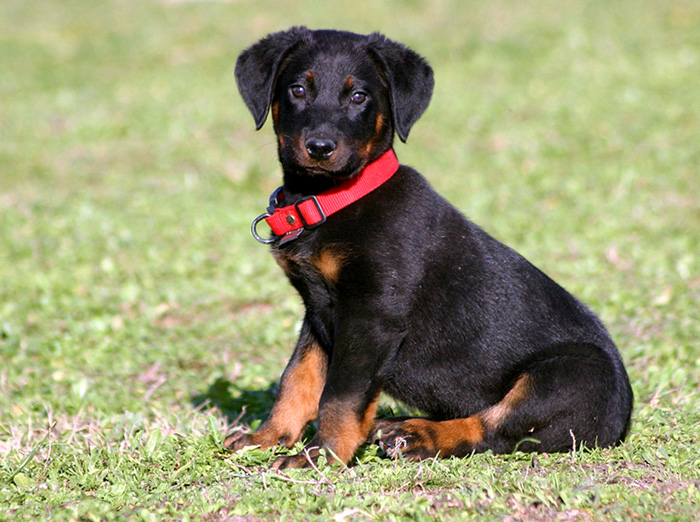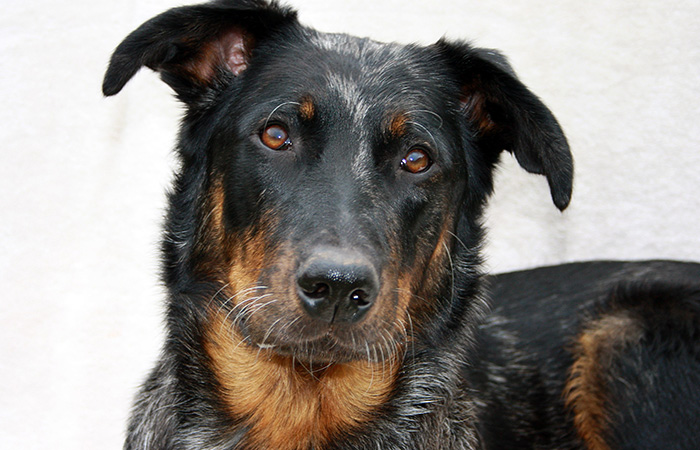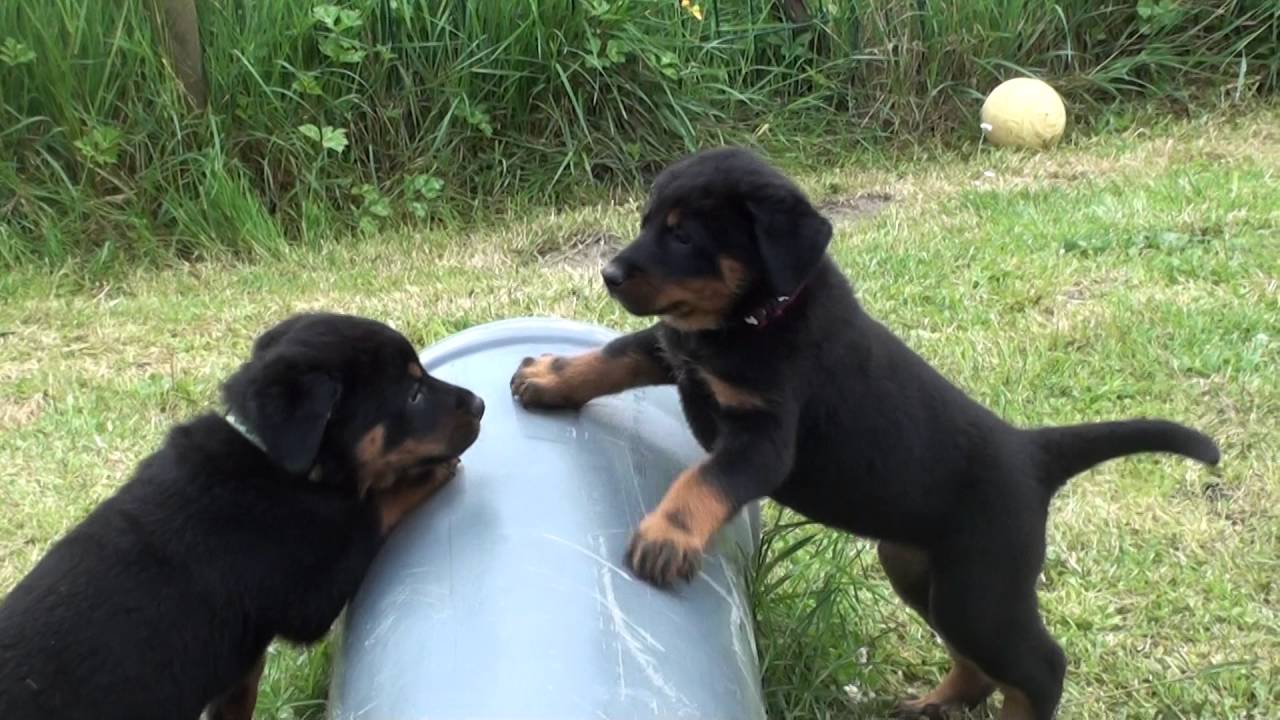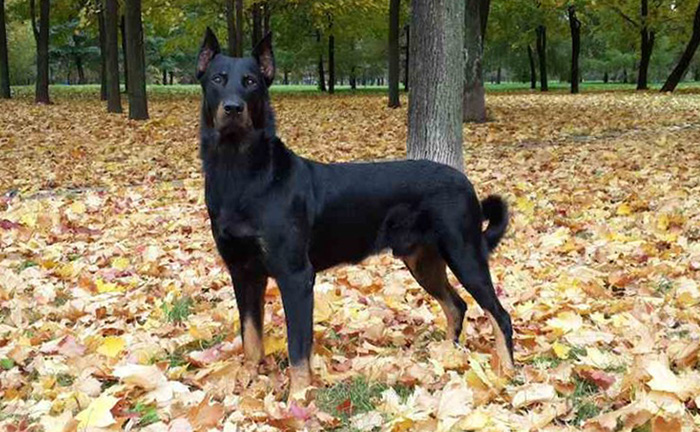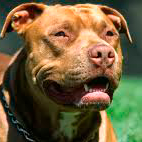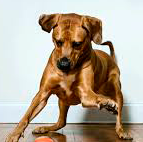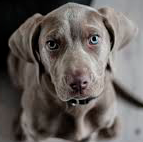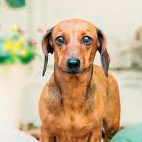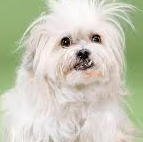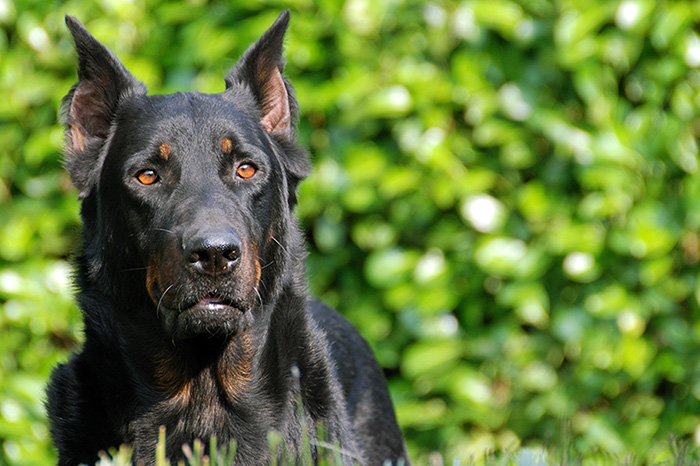
Beauceron
Beauceron pictures ➜
ORIGIN: France.
UTILISATION: Shepherd.
GENERAL APPEARANCE: A big dog, solid, robust, powerful, well built; muscular, but not heavy. Frank approach, fearless.
Penalisation: Lack of hardiness, of power, timid. Disqualification: Lack of type, too heavy, too light; dangerous or fearful (timid).
SIZE:
Dogs: from 65 to 70 cm, Bitches: from 61 to 68 cm
Disqualification: Size outside the maximum and minimum limits.
HEAD: Long (2/5 of the height at the withers), head must be proportioned to the body.
SKULL: Flat or slightly rounded from side to side; medial furrow not prominent, occipital protuberance on top of the skull is visible, head well chiselled with harmonious lines but without weakness. Stop is not pronounced, at equal distance from the tip of the nose and to the top of the skull; the width of the skull, and the height of the head slightly inferior to half of the length of the head; nasal bridge not arched (Roman nose), yet very slightly convex towards the extremity; nasal bone perceptibly parallel to the frontal bone, seen in profile.
MUZZLE: Neither narrow nor pointed; the lips must be closed, lean, always well pigmented; upper lip must cover bottom lip without looseness, they must form at the corner of the lips a very slight allusion of a pouch which must always remain firm.
TEETH: Strong, white, perfectly adapted (scissor bite). The teeth of the upper jaw covering the teeth of the lower jaw, without ever losing contact. Must be complete; there is cause, however, to take into account the functional role of each dental region.
NOSE: The nose is in relation to the muzzle, neither narrow nor too voluminous, yet well developed, never split, always black, and seen in profile must be in the extension of the upper lips.
EYES: Horizontal eye (head supposedly carried horizontally). The eye must always be dark, never less than dark hazel, even if the eyes are lightish. Eye always round shaped, only the palpebral opening changes with the breeds, and for the Beauceron, must be of a slightly oval shape.
SHEPHERD EXPRESSION: I.e. frank, never neither vicious nor timid, nor apprehensive.
EARS: Set high. If they are cropped, they will be carried erect, not divergent or convergent, tipping slightly forward. The well carried ear is the one whose middle passes through an imaginary line extending the sides of the neck. The uncropped ear must not be pressed against the head, yet look flat and rather short; the length of the uncropped ear must be equal to half the length of the head. Quality being equal, the dog with cropped ears will be preferred to the one with long ears.
Penalisation: Skull slightly too flat or too round. Stop too accentuated or insufficient. Muzzle too aquiline, too fine or too strong. Lips too tight or pendulous, corners of lips thick and flabby, insufficiently pigmented. Teeth decayed, yellow.
Missing teeth:
- 1 incisor or 1 canine or 1 molar…………………no C.A.C
- 2 small PM……………………………………….no EXCELLENT
- 2 incisors or 2 canines or 2 molars………………..no VERY GOOD
- 3 small PM……………………………………….no VERY GOOD
- 3 incisors or 3 canines or 3 molars…………………Insufficient
- 4 small PM……………………………………….Insufficient
Nose narrow, tight, away, too voluminous, too forward. Oblique eye, too protruding, not sufficiently open, lightish, apprehensive expression. Soft ears, badly carried if they are cropped, too long or twisted if they are long, badly set.
Disqualification: Head not sufficiently typical, too small or too heavy. Lack of stop or stop much too pronounced. Skull too small. Muzzle weak or too short. Lips too developed, pendulous, depigmented, inferior or superior prognathism. Lack of molars or too incomplete or defective dentition, impossibility to examine the teeth. Split nose, of colour other than black. Eye too light, of bad conformation. Ears not answering the description.
CONFORMATION: The conformation of the Beauce Shepherd is of medium proportions, i.e. harmoniously constructed without any of its regions showing any exaggeration neither shortening or lengthening, the length of the body from the point of the shoulder to the point of the butthock must be superior to the height at the withers, of:
- 1 to 1,5 cm: for the dog
- 1,5 to 2 cm : for the bitch
Neck muscular and well tied to the shoulders, proud head carriage, chest wide, long and deep, thoracic girth superior by 1/5 of the height at the withers, sternum reaching down to the point of the elbow, false ribs long and supple, oblique shoulder of medium length, straight back (level), withers well visible; loin wide and well coupled; rump only slightly slanting and only in the direction of the root of the tail; stifle not too angulated; leg standing slightly backward; strong hock, low set (not too near the ground, situated about the quarter of the height of the dog) forming with the leg a well open angle; metatarsals firm, slightly behind the point of the buttock; forearm muscular and neat; fore and hindquarters really vertical in all their lines (seen in profile, from the front and from behind).
Penalisation: Body not long enough or too long. Neck thin or thick. Dewlap, chest slightly narrow, slightly weak. Shoulder a bit straight or too laid back. Rump a little too sloping or too straight. Angulations slightly defective.
Disqualification: Lack of chest. Brisket too cylindrical. Belly too deep or too tucked up. Rangy or short coupling. Disharmony between the parts. Defective angulations. Monorchidism, cryptorchidism or atrophy.
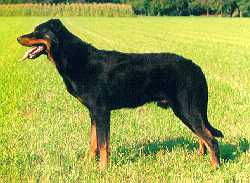
TAIL: Whole, carried hanging descending to at least the point of the hock, without deviating, Beauce shepherd …forming a slight hook in the shape of a J.
Penalisation: Slight deviation, hook a little tight or a cow tail.
Disqualification: Shortened, rolled up on itself or on the back, hook too tight, tattered tail.
COAT: Hair smooth on the head, strong, short, thick, firm lying close on the body of 3 to 4 cm long, the thighs and the underneath slightly but compulsorily fringed. Under the top coat, the undercoat is very short, fine, dense and downy of preferably mouse grey, very close; must never appear through the top coat.
Penalisation: Hair too long on head, fringes not profuse enough or of too light a shade, coat lying too close, hair with wavy tendency. The coat tends to be wavy when the coat shows, in all its length, some very slight curves while remaining lying down, in which case it is worth mentioning “has tendency to waving”.
Disqualification: Head too hairy, hair too short or too long, absence of fringes and undercoat showing through the top coat, hair too fine, tousled, wavy. The hair is “wavy” when it is neither curly, smooth or flat.
FEET: Strong, round, nails always black, pads hard but yet resilient.
Penalisation: Feet not sufficiently compact, pads too fine or lacking elasticity.
Disqualification: Feet splayed or not allowing normal work.
DEWCLAWS: Double dewclaws on hindlegs, placed on the inside forming “thumbs” well separated from one another, close to the foot. (The justification being a greater carrying surface).
Penalisation: Double dewclaw too high on the hindleg or represented by two superimposed stumps, double dewclaw on the forelegs.
Disqualification: Single dewclaw or none at all.
COLOUR:
A) Black and tan (bicolour) “red stockings”, black really definite, the tan colour must be squirrel red, the tan markings are : spots above the eyes, the lower sides of the muzzle trailing off on the cheeks, without ever reaching the bottom of the ear, on the chest two spots are preferred on the bib, the throat, under the tail; on the legs the tan is spread on the feet, up the pasterns, losing itself progressively while rising without however, invading more than a third of the leg, rising a little higher inside the legs; a few white hairs on the chest are tolerated.
B) Harlequin, black grey and tan (tricolour), the coat is in equal parts grey and black, disposed by spots or more black than grey, the tan being on the same places as for the bicolour.
Penalisation: Black not sufficiently definite, tan not blending enough into the black, tan too light or too dark, tan markings insufficient or too invasive, slight white markings on the chest. For the Harlequin, grey tone too light, too invasive.
Disqualification: White markings on the chest, tan too invasive, tan markings other than on fixed places, tan markings separated from other colours by a too distinct line. For the Harlequin, too much grey, black on one side, grey on the other, grey in the tan, head completely grey. There is ground for penalisation according to importance of fault. May lead to disqualification, all which reveals weakness or degeneration such as lack of pigmentation, depigmentation, washed out shades.
ATTITUDES: They are natural attitudes which the dog takes, it is therefore necessary to judge the Berger de Beauce in his natural positions. The exhibitor may set up his dog but the judge must retain for the qualifier: the natural positions.
GAIT/MOVEMENT: It is indispensable to judge the gaits. A herding dog cannot be completely appreciated standing still; the paces must be supple and free, the legs remaining well in line, the examiner being either behind the dog or in front. The subject uncoordinated in action shall be penalised. The paces are : the walk, the short trot, the extended trot, the gallop. The Beauce Shepherd must have an extended trot.
Penalisation: Bad positions (according to importance). The dog who, with his front feet, hits the ground rapidly and covers little terrain, who has a short trot, gallops with restricted strides, ambles at the walk.
Disqualification: Impossibility to examine the positions and gaits; no shepherd movement.
CHARACTER: Temperament must be docile, bold; all dogs aggressive without reason, timid or manifesting an exaggerated distrust, must be rejected.
N.B.: Males should have two apparently normal testicles fully descended into the scrotum.


